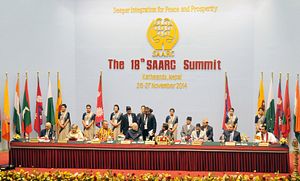It’s déjà vu all over again. Just ahead of the South Asian Association for Regional Coopreation’s (SAARC) Foreign Ministers meeting last week, Pakistan backtracked from its support for the trans-South Asian road connectivity project. Suggesting that it needed more time to consider the implications of this project, Pakistan has managed to scuttle a pact that would have allowed free movement of passenger and cargo vehicles between the SAARC nations.
After Pakistan refused to sign this pact at the Kathmandu summit of SAARC in November 2014, India along with Nepal, Bhutan, and Bangladesh decided to move ahead of their own accord. In June 2015, these states signed a landmark Motor Vehicles Agreement (MVA) for the Regulation of Passenger, Personnel, and Cargo Vehicular Traffic among the four South Asian neighbors in Thimphu, Bhutan. This major initiative is expected to pave the way for a seamless movement of people and goods across their borders for the benefit and integration of the region, thereby galvanizing economic development in South Asia at large. India only has bilateral motor vehicle agreements with Nepal and Bangladesh, but a multilateral pact would go a long way in boosting trade in the region. The agreement opens up the possibility of turning border roads into economic corridors, which could increase inter-regional trade within South Asia by 60 percent.
Taking note of the finding that transforming transport corridors into economic corridors could potentially increase intraregional trade within South Asia by almost 60 percent, and trade with the rest of the world by over 30 percent, the joint statement read, “We acknowledge that apart from physical infrastructure, the development of economic corridors within and between our countries requires the implementation of policy and regulatory measures, including the BBIN MVA, which will help address the nonphysical impediments to the seamless movement of goods vehicles and people between our four countries.”
A broader SAARC-wide agreement would have allowed the free movement of vehicles for each country — cargo as well as passenger vehicles — in the territory of other member countries through authorized operators. After Pakistan’s obstructionist stance could not be cleared, India decided to tap its eastern neighbors and the framework of the new agreement was finalized at the South Asia Subregional Economic Cooperation (SASEC) — another grouping of south Asian countries which includes India, Bangladesh, Bhutan, Maldives, Nepal and Sri Lanka. Pakistan is notably not part of this grouping. SASEC was set up in 2001 to bring together these six countries to promote regional prosperity and boost trade by improving cross border connectivity.
India is now pursuing a similar framework between itself, Myanmar, and Thailand in order to get access to the larger ASEAN market through seamless passenger and cargo movement. Among other measures is the standard operating procedure (SOP) India and Bangladesh have signed to operationalize an agreement on coastal shipping last year. The pact is aimed at promoting bilateral trade and bringing down the transportation cost of export-import cargo. India is also working on operationalizing a 3,200 km road link from Moreh (India) to Mae Sot (Thailand). According to the India-Bangladesh SOP, both countries will have to treat each other’s vessels as per international sea transportation norms.
Pakistan’s paranoia is also evident in its repeated attempts at denying the use of the land route for trade between Afghanistan and India. This has resulted in growing ill-will for Pakistan in Afghanistan, even as bilateral Afghan-India relations have continued to grow. Allowing the use of the land route for transit goods between India and Afghanistan would have opened up new possibilities for more extensive contacts in other areas, with the Pakistani transport sector directly benefiting from the transit trade. Every day that ordinary Afghans lose opportunities of easy, direct trade with India, Pakistan generates ever more resentment from them.
Covering at least 1.6 billion people across India, Pakistan, Bangladesh, Nepal, Sri Lanka, Bhutan, Maldives and Afghanistan, the South Asian Association for Regional Cooperation (SAARC), established in 1985, is one of the largest regional organizations in the world. But its achievements to date have been so minimal that even its constituents have become lackadaisical in their attitudes toward the organization. Improved connectivity in the South Asian region, both through road links and waterways, should be leveraged by regional states as a means to enhance regional cooperation and foster intraregional trade.
This can move the region beyond the blinkers created by Partition, whereby the region has more often than not missed the larger picture of mutual prosperity in pursuit of short-sighted rivalries. In South Asia, the security dynamics between a large India and its smaller neighbors have ensured that the road to economic and political cooperation will be a bumpy one. And after the emergence of China, that road has become an even more difficult one to traverse. So it is all the more imperative for New Delhi to resolutely push the project of greater regional economic cooperation forward. If Pakistan persists in its obstructionist agenda, New Delhi is right in signalling that Islamabad would find itself marginalized in the larger South Asian dynamic. Pakistan cannot hold the future of the region hostage to its India paranoia.

































